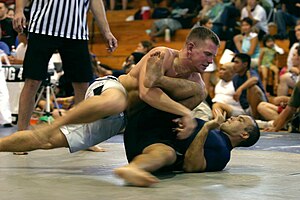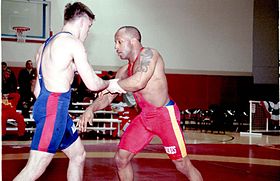Mixed Martial Arts and the Risk of Injury Scholar

Grappling, in hand-to-paw combat, describes sports that consist of gripping or seizing the opponent.[1] Grappling is used at close range to gain a physical advantage over an opponent, either by imposing a position or causing injury. Grappling is a broad term that encompasses many disciplines. These various martial arts tin be practiced both as gainsay sports and for self-defence. Grappling contests often involve takedowns and basis command, and may stop when a contestant concedes defeat, as well known every bit a submission or tap out.[2]
Grappling well-nigh ordinarily does not include striking or the utilize of weapons. However, some fighting styles or martial arts known especially for their grappling techniques teach tactics that include strikes and weapons either alongside grappling or combined with it.[3]
Types of technique [edit]

Hawaiian State Grappling Championships, Baronial 2004.


Grappling techniques can exist broadly subdivided into clinch fighting; takedowns and throws; submission holds and pinning or controlling techniques; and sweeps, reversals, turnovers, and escapes.
- Clinching: or clinch piece of work, takes place with both competitors on their feet using various clinch holds applied to the upper body of the opponent. Assure work is generally used to gear up up or defend against throws or takedowns.
- Takedowns : A takedown is used by 1 grappler to manipulate their opponent from a continuing position to a position on the ground. The grappler completing the takedown aims to end in a dominant position.
- Throws: A throw is a technique in which one grappler lifts or off-balances their opponent and maneuvers them forcefully through the air or to the basis. The purpose of throws varies among the unlike disciplines of grappling with some emphasizing throws with the potential to incapacitate the opponent, while leaving the thrower standing, or to gain a takedown or controlling position.
- Sprawling : A sprawl is a defensive technique usually used when the opponent attempts a takedown. Information technology is performed past shifting the legs backwards and spread out in one fast motion. If done correctly one volition land on their opponent'south dorsum and gain control.
- Submission holds: There are generally two types of submission holds: those that would potentially strangle or suffocate an opponent (chokes), and those that would potentially cause injury to a articulation or other trunk part (locks ). In sport grappling, a competitor is expected to submit, either verbally or by borer the opponent, to admit defeat when they are caught in a submission hold they cannot escape. Competitors who refuse to "tap out" hazard unconsciousness or serious injury.
- Securing or decision-making techniques : A pin involves property an opponent on their dorsum in a position where they are unable to assault. In some styles of competitive grappling a pivot is an instant victory, and in other styles it is considered a dominant position that is awarded with points. Other controlling techniques are used to hold an opponent face downwards on the basis or on all fours in lodge to forbid an escape or attack. Either of these types of technique may besides be used as a prelude to a submission concur.
- Escapes: In a full general sense, an escape is achieved by maneuvering out of danger or from an inferior position; for example when a grappler who is underneath side control moves to guard or gets back to a neutral standing position, or when a grappler is able to maneuver out of a submission attempt and back to a position where they are no longer in immediate danger of being submitted.
- Turnovers: used to maneuver an opponent who is on all fours or flat on their tum to their back, in order to score points, prepare for a pin or in club to gain a more dominant position.
- Reversals or sweeps: These occur when a grappler who was underneath their opponent on the ground is able to maneuver so that they proceeds a peak position over their opponent.
Use [edit]
The caste to which grappling is utilized in dissimilar fighting systems varies. Some systems, such as amateur wrestling, pehlwani, judo and Brazilian jiu-jitsu are exclusively grappling arts and do non allow striking. Another grappling arts let some express forms of striking, for example in sumo and in combat jiu jitsu it is possible to strike with open hands (slapping).[4] [5] Many combat sports, such as shooto and mixed martial arts competitions, apply both grappling and striking extensively equally part of the sport.[6] Grappling is non allowed in some martial arts and combat sports, usually for the sake of focusing on other aspects of combat such as punching, kicking or mêlée weapons. Opponents in these types of matches, however, all the same grapple with each other occasionally when fatigued or in pain; when either occurs, the referee will stride in and restart the friction match, sometimes giving a alert to one or both of the fighters. Examples of these include boxing, kickboxing, taekwondo, karate, and fencing. While prolonged grappling in Muay Thai will effect in a separation of the competitors, the art extensively uses the clinch hold known every bit a double neckband tie.
Grappling techniques and defenses to grappling techniques are likewise considered important in self-defense applications and in law enforcement. The about mutual grappling techniques taught for cocky-defense force are escapes from holds and application of pain compliance techniques.
Grappling tin can be trained for self-defense, sport, and mixed martial arts (MMA) competition.
Stand up-upwards grappling [edit]

Stand-up grappling is arguably an integral part of all grappling and clinch fighting arts, because that two combatants mostly beginning fighting from a stand-up position. The aim of stand-upward grappling varies according to the martial arts or combat sports in question. Defensive stand-up grappling concerns itself with hurting-compliance holds and escapes from possible grappling holds applied by an opponent, while offensive grappling techniques include submission holds, trapping, takedowns and throws, all of which can be used to inflict serious impairment, or to move the fight to the ground. Stand-up grappling can also be used both offensively and defensively simultaneously with striking, either to trap an opponents arms while hitting, forbid the opponent from obtaining sufficient distance to strike effectively, or to bring the opponent close to apply, for instance, knee strikes.
In combat sports, stand-upward grappling unremarkably revolves around successful takedowns and throws. Grappling is a major part of combat glima and Løse-tak sport glima, and the fight continues on the ground if both combatants end upwards at that place. In other martial sports such as MMA, the fight may continue on the basis.
Ground grappling [edit]

In judo, the aim of ground techniques (ne-waza) is to obtain a chokehold, joint lock or to pin the opponent.
Ground grappling refers to all the grappling techniques that are applied while the grapplers are no longer in a standing position. A large part of most martial arts and gainsay sports which feature basis grappling is positioning and obtaining a dominant position. A dominant position (usually on tiptop) allows the ascendant grappler a multifariousness of options, including: attempting to escape by standing upwards, obtaining a pin or hold-down to control and exhaust the opponent, executing a submission hold, or striking the opponent. The bottom grappler is, on the other hand, concerned with escaping the situation and improving their position, typically past using a sweep or reversal. In some disciplines, specially those where the baby-sit is used, the lesser grappler may likewise exist able to terminate the fight from the bottom by a submission hold. Some people feel more confident on the bottom because of the large number of submissions that tin can be accomplished from having the opponent in total-baby-sit.
Applications [edit]
When unskilled fighters become embroiled in combat, a common reaction is to grab the opponent in an attempt to slow the situation down by holding them withal, resulting in an unsystematic struggle that relies on animal force. A skilled fighter, in contrast, can perform takedowns equally a way of progressing to a superior position such as a Mount (grappling) or side control, or using clinch holds and basis positions to set upwards strikes, asphyxiate holds, and joint locks. A grappler who has been taken down to the basis can utilise defensive positions such every bit the Guard (grappling), which protects confronting being mounted or attacked. If a grappler is strong and tin use leverage well, a takedown or throw itself tin can be a fight-catastrophe maneuver; the impact can return an opponent unconscious. On the other hand, grappling besides offers the possibility of decision-making an opponent without injuring them. For their reason, nigh law staff receive some training in grappling.[ citation needed ] Too, grappling sports have been devised and then that their participants tin compete using full physical effort without injuring their opponents.
Grappling is called dumog in Eskrima. The term chin na in Chinese martial arts deals with the use of grappling to attain submission or incapacitation of the opponent (these may involve the use of acupressure points). Some Chinese martial arts, aikido, some eskrima systems, the Viking martial art of glima, likewise as medieval and Renaissance European martial arts, practice grappling while one or both participants is armed. Their practice is significantly more unsafe than unarmed grappling and generally requires a great deal of grooming.
Types of grappling [edit]

There are many different regional styles of grappling around the world that are proficient inside a limited geographic area or country. Several grappling styles like judo, shoot wrestling, Cornish wrestling, grab wrestling, submission grappling, Brazilian jiu-jitsu, sambo, hapkido and several types of wrestling including freestyle and Greco-Roman have gained global popularity. Judo, Freestyle Wrestling, and Greco-Roman Wrestling are Olympic Sports while Grappling, Brazilian Jiu-jitsu and Sambo have their own World Championship Competitions. Other known grappling-oriented systems are sumo, shuai jiao, malla-yuddha and aikido.
In these arts, the object is either to take down and pin the opponent, or to catch the antagonist in a specialized chokehold or joint lock which forces them to submit and admit defeat or be rendered helpless (unconscious or broken limbs). There are 2 forms of wearing apparel for grappling that dictate pace and way of action: with a jacket, such every bit a gi [7] or kurtka, and without (No-Gi). The jacket, or "gi", form most often utilizes grips on the cloth to control the opponent's body, while the "no-gi" class emphasizes body control of the body and head using only the natural holds provided past the trunk. The use of a jacket is compulsory in judo competition, sambo competition, and nigh Brazilian jiu-jitsu contest, equally well as a variety of folk wrestling styles around the globe. Jackets are not used in many forms of wrestling, such as Olympic Freestyle, Greco-Roman wrestling and Grappling.
Grappling techniques are also used in mixed martial arts forth with hit techniques. Strikes can exist used to set upwards grappling techniques and vice versa.
ADCC [edit]
The ADCC Submission Wrestling World Championship is the nigh prestigious submission grappling tournament in the earth and is held biannually.
Mundiais [edit]
The World Jiu-Jitsu Championship, besides commonly called the Mundiais (Portuguese for "Worlds"), is the most prestigious jacketed total range (takedown, position, and submission inclusive) grappling tournament in the world. The event also hosts a not-jacketed division (no gi), but that sub-result is not as prestigious equally ADCC in terms of pure non-jacketed competition.
United World Wrestling [edit]
United World Wrestling (UWW) is the international governing trunk for the sport of wrestling. It presides over international competitions for various forms of wrestling, including Grappling for men and women. The flagship Grappling'due south event of UWW is the Grappling World Championships.
NAGA [edit]
The North American Grappling Association (NAGA) is an system started in 1995 that holds Submission Grappling and Brazilian Jiu-Jitsu tournaments throughout North America and Europe. NAGA is the largest submission grappling clan in the world with over 175,000 participants worldwide, including some of the top submission grapplers and MMA fighters in the world.[viii] NAGA grappling tournaments consist of gi and no-gi divisions. No-Gi competitors compete under rules drafted by NAGA. Gi competitors compete under standardized Brazilian Jiu-Jitsu rules. Notable Champions Frank Mir, Joe Fiorentino, Jon Jones, Khabib Nurmagomedov, Anthony Porcelli and Antonio Bustorff.
GRiND [edit]
GRiND is the showtime Indian Pro Grappling tournament serial started in May 2022 conducting grappling championships (position and submission included). There is a first time no "Gi" event series in India.[9]
See also [edit]
- Clinch fighting
- Combatives
- Grappling hold
- Grappling position
- Ground fighting
- Submission wrestling
- Judo
- Brazilian Jiu Jitsu
- Luta Livre
- Wrestling
References [edit]
- ^ The Free Lexicon. Grappling. Accessed 2019-06-05.
- ^ Panther Grappling Club. Oft Asked Questions. Accessed 2019-06-05.
- ^ "Judo Self-Defense Forms: Goshin Jutsu". judoinfo.com.
- ^ Sumo Wrestling: Applied Techniques for the Martial Creative person
- ^ What is Combat Jiu-Jitsu?
- ^ Krauss, Erich (one December 2004). Warriors of the Ultimate Fighting Title. U.S.: Citadel Press Inc. ISBN0-8065-2657-2.
- ^ "The Judo Rank System - Belts". judoinfo.com.
- ^ "NAGA Submission Grappling, BJJ Tournaments & Reality Fighting - NagaFighter.com". nagafighter.com.
- ^ "ग्राइंड - भारत का प्रथम पेशेवर कुश्ती टूर्नामेंट" [Grind - India'south first professional grappling tournament]. Samagya Hindi Daily. 9 May 2017. p. 5. Archived from the original on xiii August 2017. Retrieved 9 May 2017.
Other sources [edit]
- Gracie; Renzo, Gracie, Royler; Peligro, Kid; Danaher, John (2001). Brazilian Jiu-Jitsu: Theory and technique. Invisible Cities Press. ISBN ane-931229-08-2.
- Ohlenkamp, Neil (2006) Judo Unleashed basic reference on judo. ISBN 0-07-147534-vi.
Source: https://en.wikipedia.org/wiki/Grappling
0 Response to "Mixed Martial Arts and the Risk of Injury Scholar"
Post a Comment